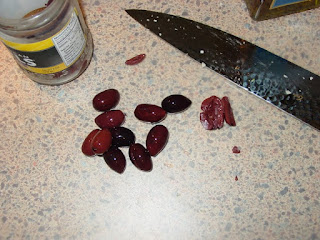UPDATE: some years after the original post I got a food mill. If you have a food mill, the straining process is much easier and takes one-tenth of the time. I've also used Ancho chiles in combination with others and enjoyed the results.
This recipe is based on an article once published on OregonLive.com but long since deleted.
For 2018, I made a Chile Colorado
Ingredients:
10# meat, usually beef but venison or pork could be fine. I used chuck roast in 2018.
2# whole dried chili peppers. California, New Mexico, Guajillo, there are many to choose from. Some are hotter or sweeter than others. Quality is important - you want them dried but still flexible. If they crumble when bent, they're too dry.
2 large onions - the biggest ones you can find, preferably a sweet variety
Water or stock, preferably stock.
Garlic
Salt
Beer
Preheat your oven to 400F.
De-stem and de-seed the peppers.
Watch for mold. If a pepper is moldy, throw it away
another moldy pepper
Once you have all of the stems and seeds removed, toast the peppers in the oven until fragrant. Do not over cook! If you can smell them with the oven door closed, they are done.
While the peppers are toasting, peel and slice the onions into 3/8-1/2" thick slices.
Remove the toasted peppers from the oven. Turn oven to broil. Char the onions under the broiler:
While the onions are broiling, move the peppers to a bowl and soak in water for 30 minutes
Place the blended pepper/onion paste into a large sieve:
Force the mixture through the screen with a rubber spatula. This will take some time.
Keep going until all that's left is pepper skin and the occasional pepper seed and all of the paste is through the screen.
Cut the meat into bite-sized pieces and brown in small batches. You want a hot pan, some good color on the meat but not overcooked inside, and not steamed like you get when you put too much meat in the pan. Use the chopped garlic and salt to season the meat as you cook it. No black pepper!
Combine the meat & paste in a large pot, add stock and beer to cover if necessary and simmer for several hours. You want to simmer it long enough for the meat to become very tender.
For those of you that like that American stew often called "chili" consisting of ground beef, kidney beans, stewed tomatoes, onions, and seasoned with "chili powder" from the spice aisle at the grocery store - I have a bonus for you. Make your so-called chili like you normally do then add a cup or so of this magic chili paste. You will never look at chili the same again.
8/2024 tips: if you freeze the chili paste in 8oz portions you can add it to nearly any red chili, even the typical American ground beef/kidney beans/stewed tomatoes variety made with grocery store chili powder. My usual batch is 3# of ground beef, 3 cans each kidney beans and stewed tomatoes, plus onion, spices, etc. and 8oz of the chili paste shown here.
















































